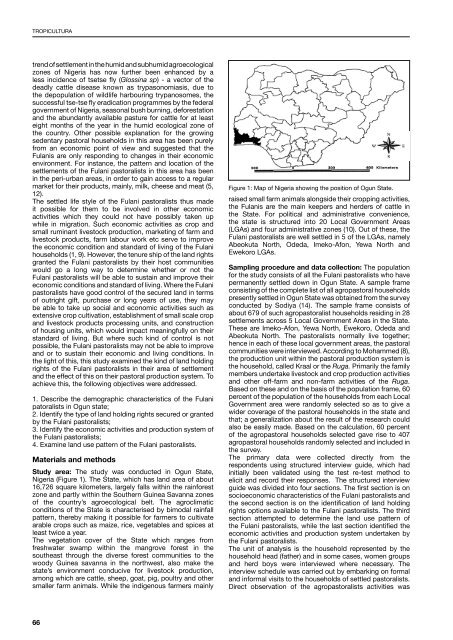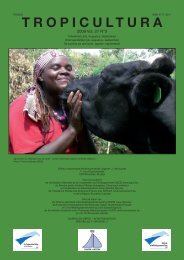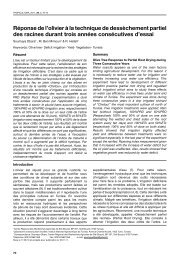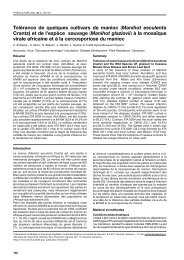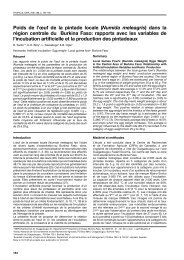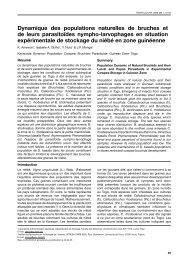Fascicule entier - Tropicultura
Fascicule entier - Tropicultura
Fascicule entier - Tropicultura
Create successful ePaper yourself
Turn your PDF publications into a flip-book with our unique Google optimized e-Paper software.
TROPICULTURA<br />
trend of settlement in the humid and subhumid agroecological<br />
zones of Nigeria has now further been enhanced by a<br />
less incidence of tsetse fly (Glossina sp) - a vector of the<br />
deadly cattle disease known as trypasonomiasis, due to<br />
the depopulation of wildlife harbouring trypanosomes, the<br />
successful tse-tse fly eradication programmes by the federal<br />
government of Nigeria, seasonal bush burning, deforestation<br />
and the abundantly available pasture for cattle for at least<br />
eight months of the year in the humid ecological zone of<br />
the country. Other possible explanation for the growing<br />
sedentary pastoral households in this area has been purely<br />
from an economic point of view and suggested that the<br />
Fulanis are only responding to changes in their economic<br />
environment. For instance, the pattern and location of the<br />
settlements of the Fulani pastoralists in this area has been<br />
in the peri-urban areas, in order to gain access to a regular<br />
market for their products, mainly, milk, cheese and meat (5,<br />
12).<br />
The settled life style of the Fulani pastoralists thus made<br />
it possible for them to be involved in other economic<br />
activities which they could not have possibly taken up<br />
while in migration. Such economic activities as crop and<br />
small ruminant livestock production, marketing of farm and<br />
livestock products, farm labour work etc serve to improve<br />
the economic condition and standard of living of the Fulani<br />
households (1, 9). However, the tenure ship of the land rights<br />
granted the Fulani pastoralists by their host communities<br />
would go a long way to determine whether or not the<br />
Fulani pastoralists will be able to sustain and improve their<br />
economic conditions and standard of living. Where the Fulani<br />
pastoralists have good control of the secured land in terms<br />
of outright gift, purchase or long years of use, they may<br />
be able to take up social and economic activities such as<br />
extensive crop cultivation, establishment of small scale crop<br />
and livestock products processing units, and construction<br />
of housing units, which would impact meaningfully on their<br />
standard of living. But where such kind of control is not<br />
possible, the Fulani pastoralists may not be able to improve<br />
and or to sustain their economic and living conditions. In<br />
the light of this, this study examined the kind of land holding<br />
rights of the Fulani pastoralists in their area of settlement<br />
and the effect of this on their pastoral production system. To<br />
achieve this, the following objectives were addressed.<br />
1. Describe the demographic characteristics of the Fulani<br />
patoralists in Ogun state;<br />
2. Identify the type of land holding rights secured or granted<br />
by the Fulani pastoralists;<br />
3. Identify the economic activities and production system of<br />
the Fulani pastoralists;<br />
4. Examine land use pattern of the Fulani pastoralists.<br />
Materials and methods<br />
Study area: The study was conducted in Ogun State,<br />
Nigeria (Figure 1). The State, which has land area of about<br />
16,726 square kilometers, largely falls within the rainforest<br />
zone and partly within the Southern Guinea Savanna zones<br />
of the country’s agroecological belt. The agroclimatic<br />
conditions of the State is characterised by bimodal rainfall<br />
pattern, thereby making it possible for farmers to cultivate<br />
arable crops such as maize, rice, vegetables and spices at<br />
least twice a year.<br />
The vegetation cover of the State which ranges from<br />
freshwater swamp within the mangrove forest in the<br />
southeast through the diverse forest communities to the<br />
woody Guinea savanna in the northwest, also make the<br />
state’s environment conducive for livestock production,<br />
among which are cattle, sheep, goat, pig, poultry and other<br />
smaller farm animals. While the indigenous farmers mainly<br />
66<br />
Figure 1: Map of Nigeria showing the position of Ogun State.<br />
raised small farm animals alongside their cropping activities,<br />
the Fulanis are the main keepers and herders of cattle in<br />
the State. For political and administrative convenience,<br />
the state is structured into 20 Local Government Areas<br />
(LGAs) and four administrative zones (10). Out of these, the<br />
Fulani pastoralists are well settled in 5 of the LGAs, namely<br />
Abeokuta North, Odeda, Imeko-Afon, Yewa North and<br />
Ewekoro LGAs.<br />
Sampling procedure and data collection: The population<br />
for the study consists of all the Fulani pastoralists who have<br />
permanently settled down in Ogun State. A sample frame<br />
consisting of the complete list of all agropastoral households<br />
presently settled in Ogun State was obtained from the survey<br />
conducted by Sodiya (14). The sample frame consists of<br />
about 679 of such agropastoralist households residing in 28<br />
settlements across 5 Local Government Areas in the State.<br />
These are Imeko-Afon, Yewa North, Ewekoro, Odeda and<br />
Abeokuta North. The pastoralists normally live together;<br />
hence in each of these local government areas, the pastoral<br />
communities were interviewed. According to Mohammed (8),<br />
the production unit within the pastoral production system is<br />
the household, called Kraal or the Ruga. Primarily the family<br />
members undertake livestock and crop production activities<br />
and other off-farm and non-farm activities of the Ruga.<br />
Based on these and on the basis of the population frame, 60<br />
percent of the population of the households from each Local<br />
Government area were randomly selected so as to give a<br />
wider coverage of the pastoral households in the state and<br />
that; a generalization about the result of the research could<br />
also be easily made. Based on the calculation, 60 percent<br />
of the agropastoral households selected gave rise to 407<br />
agropastoral households randomly selected and included in<br />
the survey.<br />
The primary data were collected directly from the<br />
respondents using structured interview guide, which had<br />
initially been validated using the test re-test method to<br />
elicit and record their responses. The structured interview<br />
guide was divided into four sections. The first section is on<br />
socioeconomic characteristics of the Fulani pastoralists and<br />
the second section is on the identification of land holding<br />
rights options available to the Fulani pastoralists. The third<br />
section attempted to determine the land use pattern of<br />
the Fulani pastoralists, while the last section identified the<br />
economic activities and production system undertaken by<br />
the Fulani pastoralists.<br />
The unit of analysis is the household represented by the<br />
household head (father) and in some cases, women groups<br />
and herd boys were interviewed where necessary. The<br />
interview schedule was carried out by embarking on formal<br />
and informal visits to the households of settled pastoralists.<br />
Direct observation of the agropastoralists activities was


